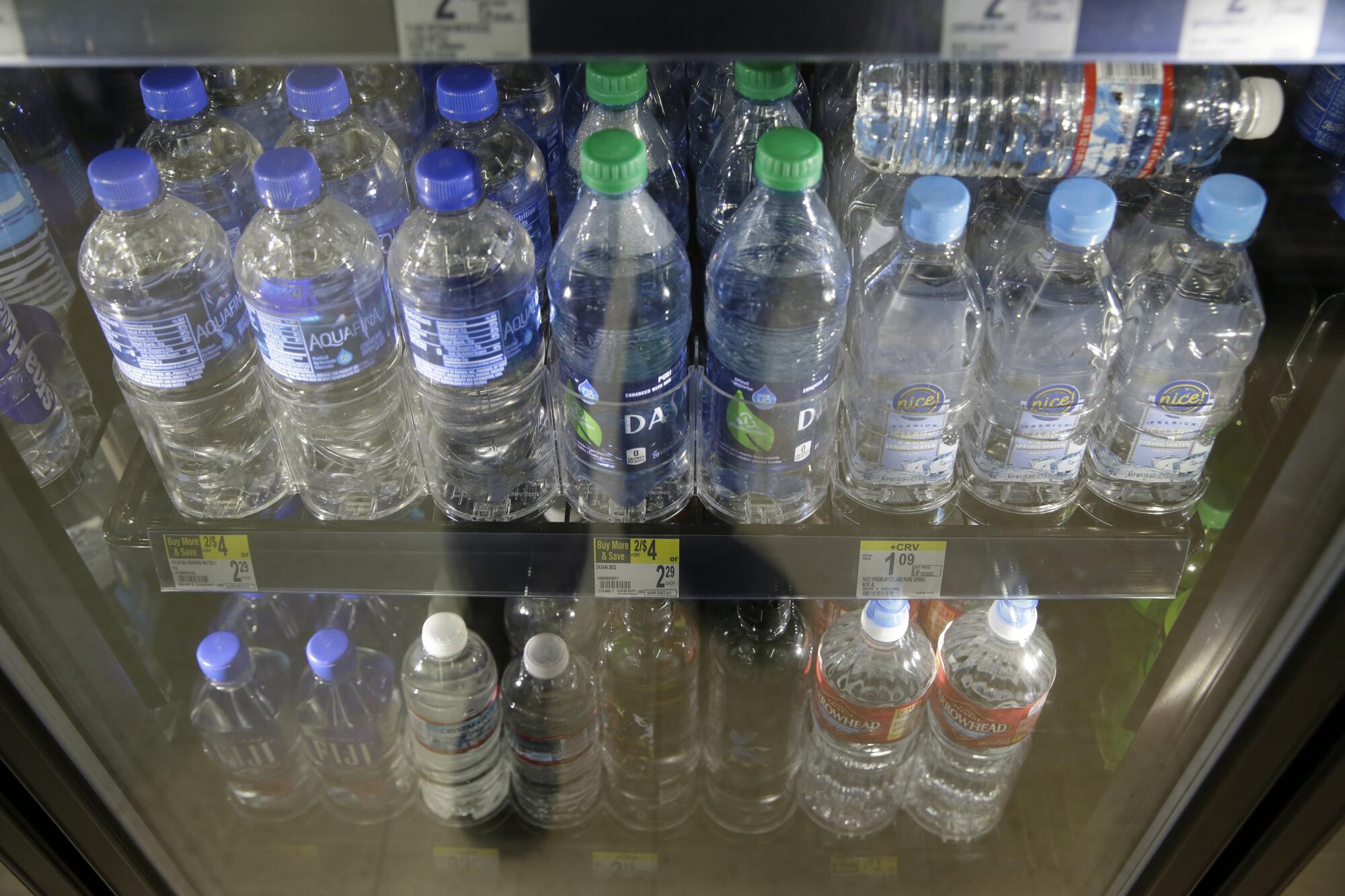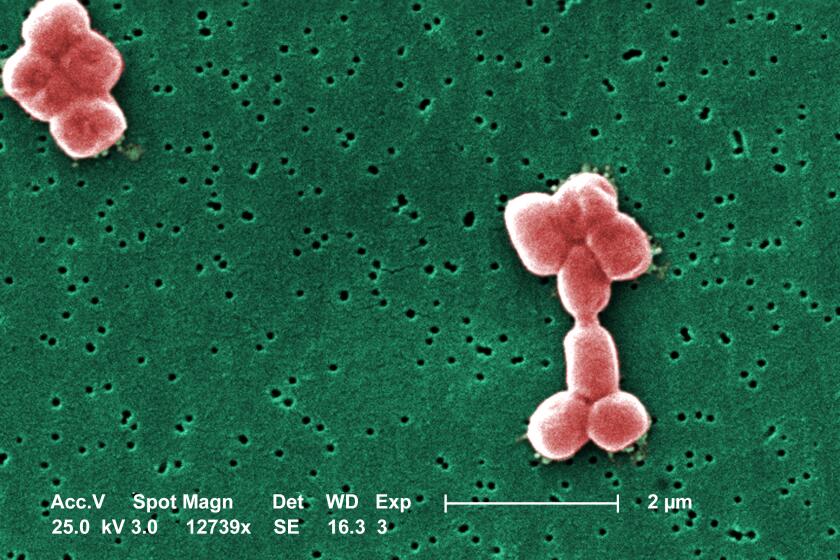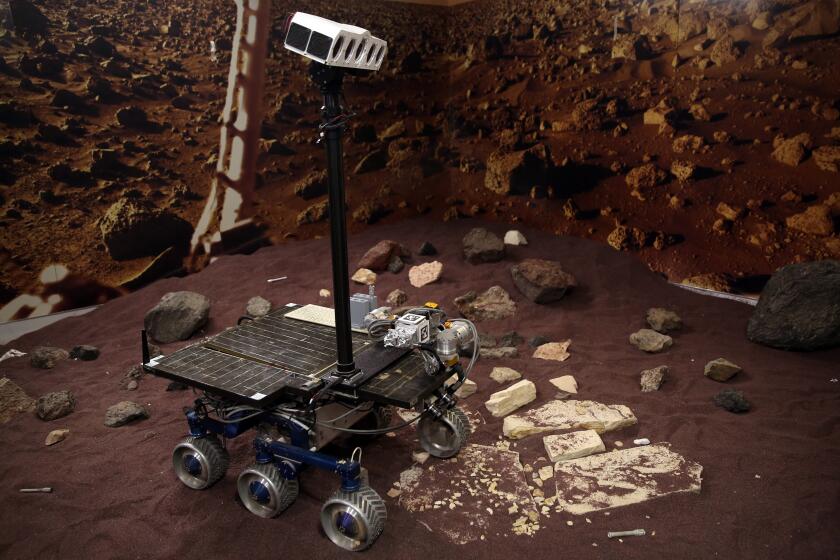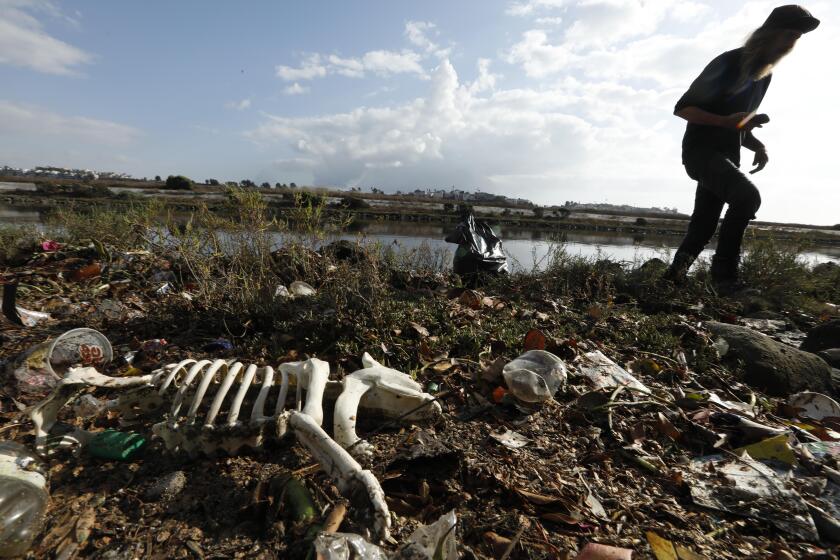
- Share via
It seems anywhere scientists look for plastic, they find it: from the ice in Antarctica, to the first bowel movement produced by newborn babies.
Now, researchers are finding that the amount of microscopic plastics floating in bottled drinking water is far greater than initially believed.
Using sophisticated imaging technology, scientists at Columbia University’s Lamont-Doherty laboratory examined water samples from three popular brands (they won’t say which ones) and found hundreds of thousands of bits of plastic per liter of water.
Ninety percent of those plastics were small enough to qualify as nanoplastics: microscopic flecks so small that they can be absorbed into human cells and tissue, as well as cross the blood-brain barrier.
For the first time in half a century, researchers have identified a new antibiotic that appears to kill a deadly, drug-resistant superbug.
The research, which was published Monday in the journal Proceedings of the National Academy of Sciences, raises new concerns about the potentially harmful health effects — and prevalence — of nanoplastics. The researchers found that the quantity of such particles was 10 to 100 times greater than previously estimated.
“For a long time before this study, I actually thought that what was inside bottled water [in terms of] nanoplastics was just a few hundred PET particles,” said Naixin Qian, a Columbia chemistry graduate student and the study’s lead author. “It turns out to be much more than that.” PET, or polyethylene terephthalate, is a type of clear plastic that is commonly used for single-use water bottles.
Microplastics — particles that range from 1 micrometer to 5 milimeters in size — have been documented in bottled and tap water for several years. But the identification of nanoplastics — particles that measure just billionths of a meter — is raising alarms.
The incredibly small size of nanoparticles allows them to behave differently than larger pieces of matter, said Beizhan Yan, a Columbia environmental chemist and a co-author of the study.
Pollutants and pathogens can be carried on the surface of a particle, and the smaller a particle gets, the larger its surface area-to-volume ratio becomes.
As a result, Yan said, “even if they’re not that toxic at a larger particle size, when they become smaller they become toxic, because they can interfere in the cells, in the tissues, inside of the organelles.”
Research on the effects of plastic on human health is still in its infancy. It’s only been recently that scientists have identified the presence of plastics in people’s bodies and organs.
But research on other animals suggests a strong, negative influence on health. In laboratory studies of fish and rodents, microplastics were shown to interfere with development, reproductive ability and health, gut health, hormone levels, immune responses, the heart and more.
The head of NASA’s Jet Propulsion Laboratory warns that jobs at the lab will be in jeopardy if proposed funding cuts for the Mars Sample Return mission go through.
Study authors used a new type of microscope that can image the vibration of molecules to analyze the nanoparticles against a library of seven common plastics. They were unsurprised to find tiny bits of PET, as that’s what the bottles were made of. However, the amount of PET was dwarfed by the amount of polyamides, a form of nylon used in the reverse osmosis filters that water is run through before bottling.
Other plastics confirmed in the water in microscopic quantities include polystyrene, polyvinyl chloride and polymethyl methacrylate, also known as plexiglass. But only 10% of the nanoparticles analyzed could be classified as one of those seven known plastics, the researchers found. The origin of the rest is unknown.
During the past several years, researchers have identified microplastics from the deepest oceanic waters to the snowy tops of the planet’s highest mountains. They’ve found it in human blood, lung tissue and in the brain, and in organisms ranging from worms and zooplankton to whales and polar bears.
In some cases, the particles are ingested with food and water. In other cases, they are inhaled — scientists have found them in outdoor and indoor air, as well as in clouds — or absorbed through the skin.
The laundering of synthetic clothing and the breaking down of automobile tires are two of the largest sources of airborne plastics.
“As people, we are in environments where plastic is everywhere,” Yan said.
There’s also evidence that these small particles bioaccumulate, or grow more concentrated as they move up the food chain from one organism to the next.
Though the Columbia study didn’t analyze samples of tap water, previous studies looking at microplastics have found much lower concentrations of those particles in tap water than in bottled water.
Food packaging is also a known source of plastic contamination in food. On Jan. 4, Consumer Reports released the results of its investigation into plastic chemicals in common processed foods widely available in the U.S.
Plastic chemicals and nanoplastics “are part of the same problem, but they’re two totally different animals,” said James E. Rogers, a microbiologist who is acting director of product safety at Consumer Reports. “One is a chemical and one is a physical piece, even if it is micro-sized.”
Atty. Gen. Rob Bonta claims Exxon Mobil and other corporations have perpetuated the ‘myth’ that recycling will solve the plastics crisis.
Of the 85 food products tested, 84 had traces of phthalates, the most common type of chemical used to make plastic more durable. Nearly 80% of the foods contained bisphenols, another industrial chemical.
Both phthalates and bisphenols are known endocrine disruptors, meaning they interfere with the body’s hormonal systems. Exposure to these chemicals over time is associated with higher risks of diabetes, obesity, cancers and fertility problems, Rogers said.
“You may not be able to get to zero exposure, but at least you can reduce your risk by reducing your exposure,” Rogers said. “Cut out the fast food. Eat less processed foods. Eat less fatty food.”
Now that they’ve grossed us out about bottled water, the Columbia team are looking at how else they can use stimulated Raman scattering microscopy to seek out nanoplastics in other areas of life.
One project looks at the nanoplastics in exhaust and wastewater from commercial and residential washers and dryers. A pair of British adventurers currently trekking across Antarctica are collecting samples of snow for the team to analyze. The Columbia team is also collaborating with other research institutions to measure nanoplastics in human tissues and try to understand their effects on health.
And a group at the University of Waterloo, in Canada, are using artificial intelligence to help sort through the plastic bits they find in wastewater — providing a novel, and potentially more powerful and accurate, way of identifying different and often difficult to identify varieties of plastic in water samples.
“It’s an example of using AI for good,” said Wayne Parker, a professor of civil and environmental engineering at the school.
Methods like AI, or the technology used by the Columbia team to identify micro- and nanoplastics, will enable researchers to better identify “and assess the risks of these of these particles” in the environment and in ourselves, Parker said.











